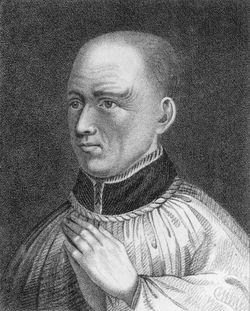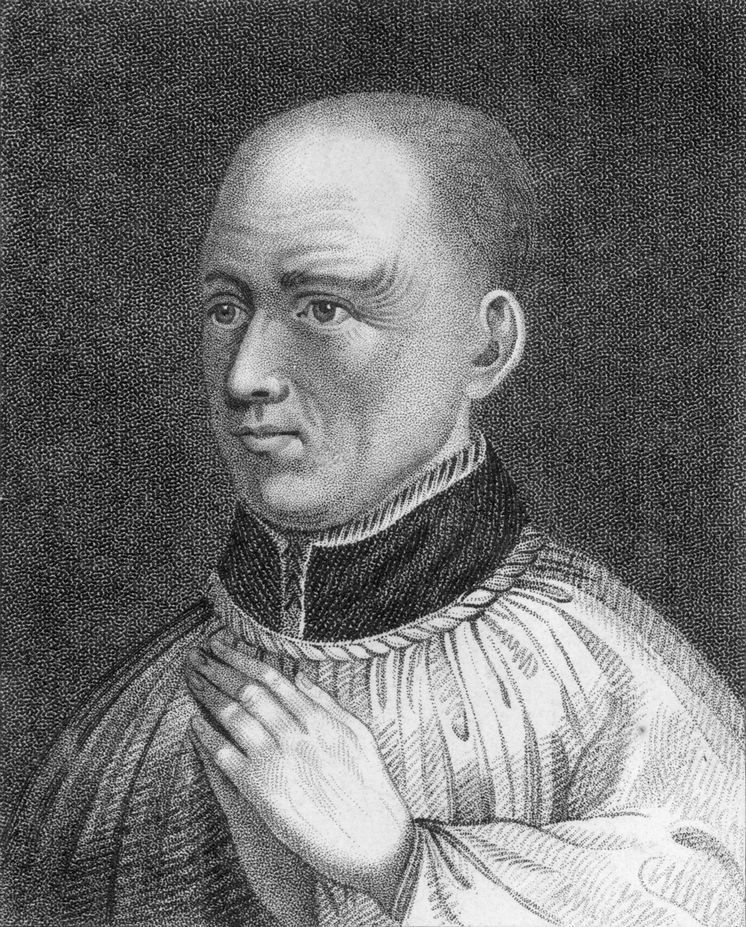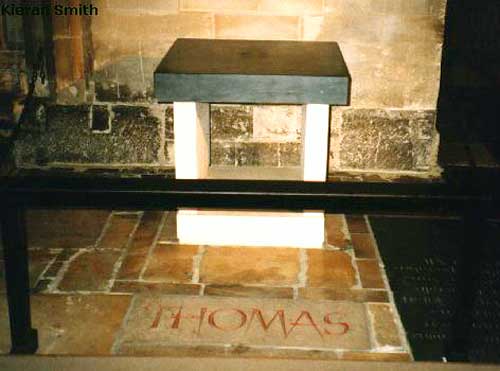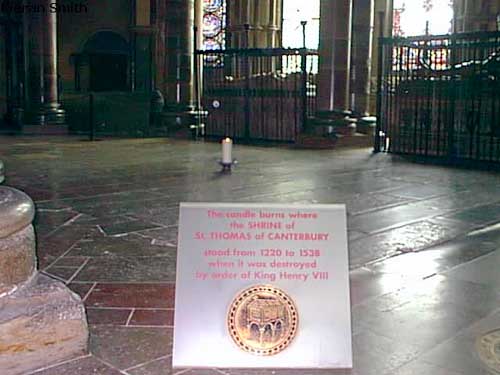Thomas Becket was born on December 21, 1118, (or in 1120 according to later tradition). At the age of 10, he was sent as a student to Merton Priory in England and later attended a grammar school in London. Sometime after he began his schooling, his father fell on hard times, and Thomas was forced to earn a living as a clerk, first in the business of a relative, and later, in a position in the household of Theobald of Bec, by now the Archbishop of Canterbury.
Theobald entrusted him with several important missions to Rome, Italy; and also sent him to Bologna, Italy; and Auxerre, France; to study Canon Law. In 1154, he was named Archdeacon of Canterbury. Other ecclesiastical offices included a number of benefices, prebends (stipends drawn by a Canon from the endowment of a cathedral), at Lincoln Cathedral and St. Paul's Cathedral and the office of Provost of Beverley. His efficiency in those posts led to Theobald recommending him to King Henry II for the vacant post of Lord Chancellor, to which he was appointed in January 1155.
In 1162, he was nominated as Archbishop of Canterbury following Theobald's death in April, 1161, and his election was confirmed in May 1162. On June 2, 1162, he was ordained a priest and consecrated Archbishop the following day.
In January 1164, King Henry II presided over the assemblies of most of the higher English clergy at Clarendon Palace in Wiltshire, England, where he sought less clerical independence and a weaker connection with Rome. He obtained consent from all except Becket, who expressed his willingness to agree to the substance of the Constitutions of Clarendon, but refused to formally sign the documents. Henry summoned him to appear before a Great Council at Northampton Castle in Northampton, England, on October 8, 1164, to answer allegations of contempt of royal authority and malfeasance in the Chancellor's office. Convicted on the charges, Becket stormed out of the trial and fled to mainland Europe, where King Louis VII of France offered him protection. He spent nearly two years in the Cistercian Abbey of Pontigny in Burgundy, France, until Henry's threats against the order obliged him to return to Sens. Becket retaliated by threatening excommunication and interdict against Henry II and the English bishops, but Pope Alexander III, though sympathizing with him in theory, favored a more diplomatic approach. In 1170, Pope Alexander III sent delegates to impose a solution to the dispute and, at that point, Henry II offered a compromise that would allow Becket to return to England from exile.
In June of that year, Roger de Pont L'Eveque, the Archbishop of York, along with Gilbert Foliot, the Bishop of London, and Josceline de Bohon, the Bishop of Salisbury, crowned Henry the Young, the heir apparent to Henry II, King at York. This was a breach of Canterbury's privilege of coronation, and, in November 1170, Becket excommunicated all three, and they fled to Normandy, France. He continued to excommunicate his opponents in the church, and, upon hearing reports of his actions, Henry II is said to have uttered words that were interpreted by his men as a royal command to have Becket killed.
Four of his knights travelled to Canterbury to confront him. On December 29, 1170, they arrived at Canterbury and, according to accounts left by the monk Gervase of Canterbury and eyewitness Edward Grim, they placed their weapons under a tree outside the cathedral and hid their mail armor under cloaks before entering to challenge Becket. The knights informed him that he was to go to Winchester to give an account of his actions, but he refused. The knights then retrieved their weapons and rushed back inside for, catching up with him in a spot near a door to the monastic cloister, the stairs into the crypt, and the stairs leading up into the choir of the cathedral. With their swords drawn, they murdered him, with the fatal blow being a sword driven through the top of his skull. Becket was around 50 years old at the time of his death.
On February 21, 1173, he was canonized as a saint and martyr by Pope Alexander III. In 1220, his remains were relocated from his first tomb to a shrine in the recently-completed Trinity Chapel. The shrine stood there until it was destroyed in 1538 during the Dissolution of the Monasteries during the reign of English King Henry VIII. Henry also destroyed Becket's bones and ordered that all mention of his name be obliterated.
His feast day is celebrated on December 29 in both the Roman Catholic and Anglican Churches. The 'à' with which his name is frequently listed appears to be a post-Reformation creation, possibly in imitation of Thomas à Kempis.
In 1884, England's poet laureate Alfred, Lord Tennyson, wrote "Becket," a play about Thomas Becket and Henry II. Modern works based on the story of Thomas Becket include T. S. Eliot's play, "Murder in the Cathedral," Jean Anouilh's play, "Becket," which was made into a movie with the same title; and Paul Webb's play, "Four Nights in Knaresborough." The struggle between the Church's and the King's power is a theme of Ken Follett's novel, "The Pillars of the Earth," of which one of the last scenes features the murder of Thomas Becket. There are numerous churches in England that are named after him.
Thomas Becket was born on December 21, 1118, (or in 1120 according to later tradition). At the age of 10, he was sent as a student to Merton Priory in England and later attended a grammar school in London. Sometime after he began his schooling, his father fell on hard times, and Thomas was forced to earn a living as a clerk, first in the business of a relative, and later, in a position in the household of Theobald of Bec, by now the Archbishop of Canterbury.
Theobald entrusted him with several important missions to Rome, Italy; and also sent him to Bologna, Italy; and Auxerre, France; to study Canon Law. In 1154, he was named Archdeacon of Canterbury. Other ecclesiastical offices included a number of benefices, prebends (stipends drawn by a Canon from the endowment of a cathedral), at Lincoln Cathedral and St. Paul's Cathedral and the office of Provost of Beverley. His efficiency in those posts led to Theobald recommending him to King Henry II for the vacant post of Lord Chancellor, to which he was appointed in January 1155.
In 1162, he was nominated as Archbishop of Canterbury following Theobald's death in April, 1161, and his election was confirmed in May 1162. On June 2, 1162, he was ordained a priest and consecrated Archbishop the following day.
In January 1164, King Henry II presided over the assemblies of most of the higher English clergy at Clarendon Palace in Wiltshire, England, where he sought less clerical independence and a weaker connection with Rome. He obtained consent from all except Becket, who expressed his willingness to agree to the substance of the Constitutions of Clarendon, but refused to formally sign the documents. Henry summoned him to appear before a Great Council at Northampton Castle in Northampton, England, on October 8, 1164, to answer allegations of contempt of royal authority and malfeasance in the Chancellor's office. Convicted on the charges, Becket stormed out of the trial and fled to mainland Europe, where King Louis VII of France offered him protection. He spent nearly two years in the Cistercian Abbey of Pontigny in Burgundy, France, until Henry's threats against the order obliged him to return to Sens. Becket retaliated by threatening excommunication and interdict against Henry II and the English bishops, but Pope Alexander III, though sympathizing with him in theory, favored a more diplomatic approach. In 1170, Pope Alexander III sent delegates to impose a solution to the dispute and, at that point, Henry II offered a compromise that would allow Becket to return to England from exile.
In June of that year, Roger de Pont L'Eveque, the Archbishop of York, along with Gilbert Foliot, the Bishop of London, and Josceline de Bohon, the Bishop of Salisbury, crowned Henry the Young, the heir apparent to Henry II, King at York. This was a breach of Canterbury's privilege of coronation, and, in November 1170, Becket excommunicated all three, and they fled to Normandy, France. He continued to excommunicate his opponents in the church, and, upon hearing reports of his actions, Henry II is said to have uttered words that were interpreted by his men as a royal command to have Becket killed.
Four of his knights travelled to Canterbury to confront him. On December 29, 1170, they arrived at Canterbury and, according to accounts left by the monk Gervase of Canterbury and eyewitness Edward Grim, they placed their weapons under a tree outside the cathedral and hid their mail armor under cloaks before entering to challenge Becket. The knights informed him that he was to go to Winchester to give an account of his actions, but he refused. The knights then retrieved their weapons and rushed back inside for, catching up with him in a spot near a door to the monastic cloister, the stairs into the crypt, and the stairs leading up into the choir of the cathedral. With their swords drawn, they murdered him, with the fatal blow being a sword driven through the top of his skull. Becket was around 50 years old at the time of his death.
On February 21, 1173, he was canonized as a saint and martyr by Pope Alexander III. In 1220, his remains were relocated from his first tomb to a shrine in the recently-completed Trinity Chapel. The shrine stood there until it was destroyed in 1538 during the Dissolution of the Monasteries during the reign of English King Henry VIII. Henry also destroyed Becket's bones and ordered that all mention of his name be obliterated.
His feast day is celebrated on December 29 in both the Roman Catholic and Anglican Churches. The 'à' with which his name is frequently listed appears to be a post-Reformation creation, possibly in imitation of Thomas à Kempis.
In 1884, England's poet laureate Alfred, Lord Tennyson, wrote "Becket," a play about Thomas Becket and Henry II. Modern works based on the story of Thomas Becket include T. S. Eliot's play, "Murder in the Cathedral," Jean Anouilh's play, "Becket," which was made into a movie with the same title; and Paul Webb's play, "Four Nights in Knaresborough." The struggle between the Church's and the King's power is a theme of Ken Follett's novel, "The Pillars of the Earth," of which one of the last scenes features the murder of Thomas Becket. There are numerous churches in England that are named after him.
Bio by: Find a Grave
Family Members
Advertisement







